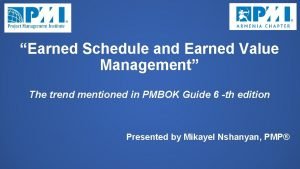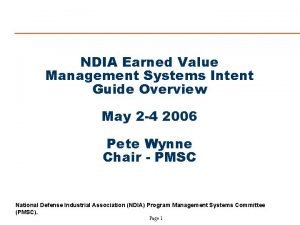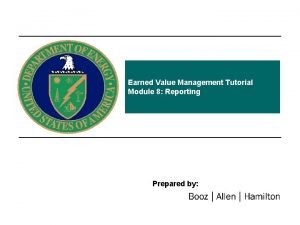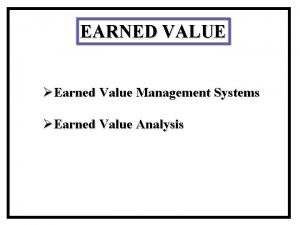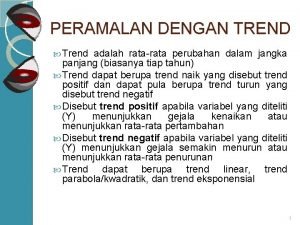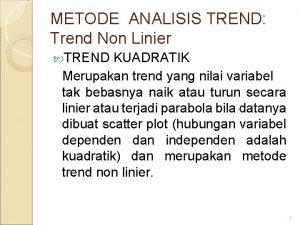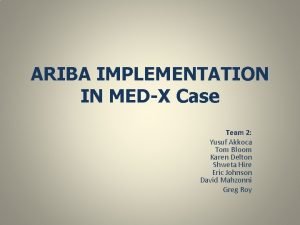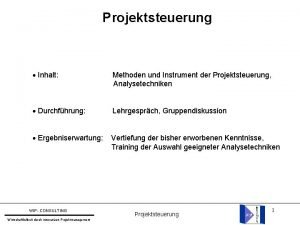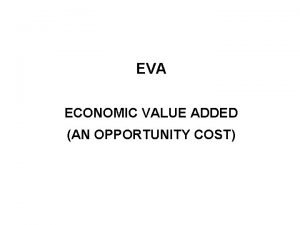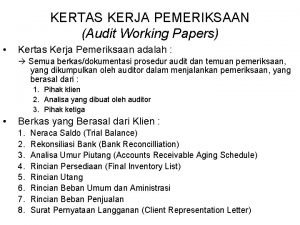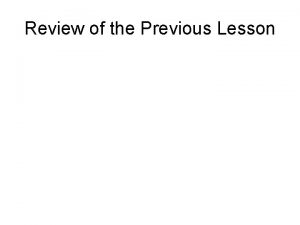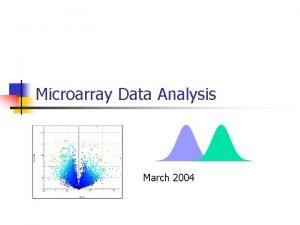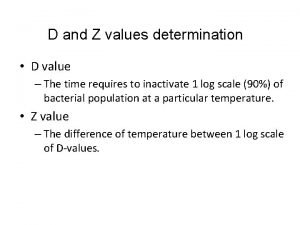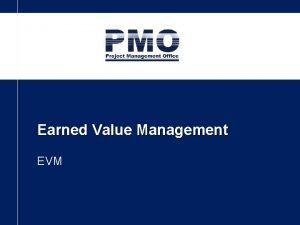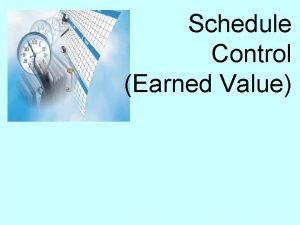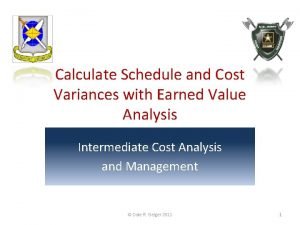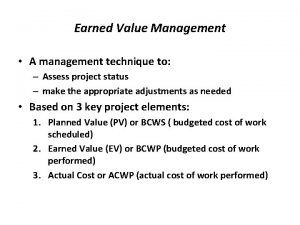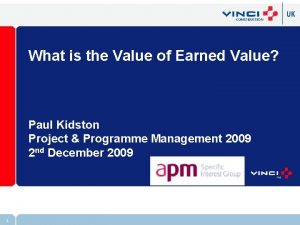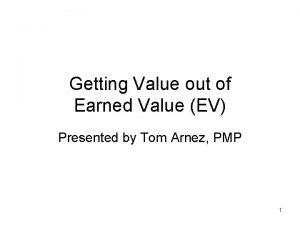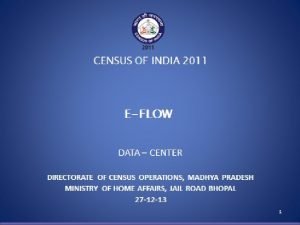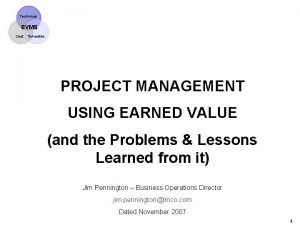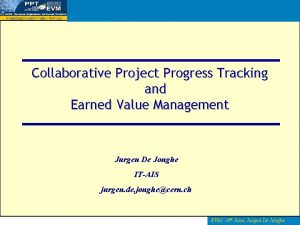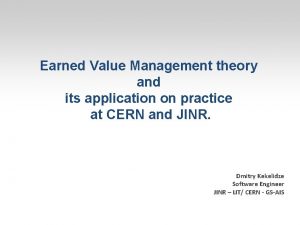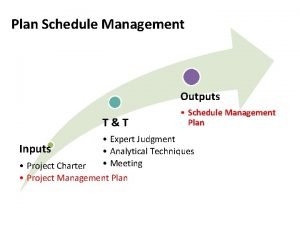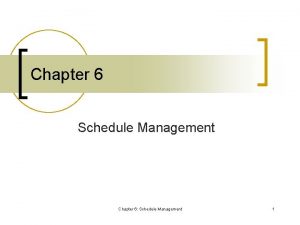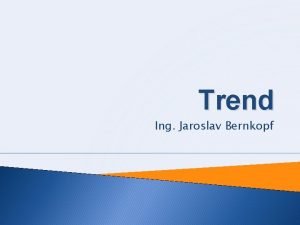Earned Schedule and Earned Value Management The trend







































- Slides: 39

“Earned Schedule and Earned Value Management” The trend mentioned in PMBOK Guide 6 -th edition Presented by Mikayel Nshanyan, PMP®

Structural Changes in PMBOK Guide 6 –th Edition TRENDS AND EMERGING PRACTICE IN PROJECT COST MANAGEMENT “Within the practice of Project Cost Management, trends include the expansion of earned value management (EVM) to include the concept of earned schedule (ES)”. PMBOK Guide 6 –th Edition, 2017, Ch. 7, p. 233

Scope - WBS Contract Budget Base $ Schedule Management Reserve Performance Measurement Baseline Budget $25 K $12 K $37 K $45 K $55 K $14 K Time

Earned Value Management is needed because. . . § In a single integrated system, Earned Value Management is able to provide accurate forecasts of project performance problems, which is an important contribution for project management. • It provides an “early warning” signal for prompt corrective action • Still time to recover • Timely request for additional resources.

Historical Background of EVM § Cost/Schedule Control Systems Criteria (C/SCSC), 1967; US Department of Defense (Do. D) § EVM System (EVMS), 1998; ANSI /EIA § PMBOK Guide 2 –nd, 3 –rd, 4 –th, 5 –th, 6 – th Editions; PMI® § Practice Standard for Eearned Value Management, 2005, 2011; PMI® § Including EVM in PMP Certification Exam Program since 2000; PMI®

Use of EVM § EVM is now used in projects and programs world-wide. § Primary users include the US, Europe, UK, Canada, Australia, China and Japan. § EVM is a requirement of many US agencies, including the Department of Defence (Do. D), NASA, the Department of Energy (Do. E), the Intelligence Community, the Department of Homeland Security (DHS), the Federal Aviation Administration (FAA), the Department of Transportation (Do. T), the Department of Health and Human Services (HHS) and others. § EVM is applicable not only to waterfall but also to agile projects.

Benefits of EVM usage § There are significant benefits to the contractor and to the customer. § Contractor benefits include increased visibility and control to quickly and proactively respond to issues, which makes it easier to meet project schedule, cost and technical objectives. § Custormer benefits include confidence in the contractor`s abiity to manage the project, identify problems early and provide objective, rather than subjective, contract cost and schedule status.

Basic Terms in EVM § PV – Planned Value Planned cost of the total amount of work scheduled to be performed to date. § AC – Actual Cost actually incurred to accomplish the work that has been done to date. § EV – Earned Value The planned (not actual) cost of work that has been done to date.

Some Derived Metrics § Cost Variance (CV): CV = EV – AC § Schedule Variance (SV): SV = EV – PV § Cost Performance Index (CPI): CPI = EV / AC § Schedule Performance Index (SPI): SPI = EV / PV

Earned Value Metrics § Method to measure project performance against scope, schedule and cost baseline (performance measurement baseline) § Interpretation of basic EVM performance measures Performance Measures Schedule SV > 0; SPI > 1 SV = 0; SPI = 1 SV < 0; SPI < 1 CV > 0; CPI > 1 Ahead of schedule, Under budget On schedule, Under the budget Behind schedule, Under the budget CV = 0; CPI = 1 Ahead of schedule, On budget On schedule, On budget Behind schedule, On budget CV < 0; CPI < 1 Ahead of schedule, Over budget On schedule, Over budget Behind schedule, Over budget Cost

EVM - Graphical Representation Cost Estimate at Completion Budget at Completion Projection of cost: variance at completion (VAC) EAC BAC AC Cost Variance (CV) PV EV Schedule Variance (SV) ACTUAL PLAN Projection of Schedule: delay at completion EARNED VALUE Status date Time Project is over budget and behind schedule

Cost Project Performance Variances × × Ahead schedule: SV > 0 × EV AC Under budget (saving): CV > 0 PV Status date Time

Project Performance Variances Cost Behinde schedule (delay): SV < 0 × × EV PV AC Status date Under budget (saving): CV > 0 Time

Project Performance Variances Cost Behinde schedule (delay): SV < 0 PV × × AC × EV Over budget (overspending): CV < 0 Status date Time

Cost Project Performance Variances Over budget (overspending): CV < 0 × × × AC EV Ahead schedule: SV > 0 PV Status date Time

Project Cost Forecusting in EVM § Variances are atypical: EAC = AC + ( BAC - EV ) § Past estimating assumptions are not valid: EAC = AC + ETC § Variances will be present in the future and time is the constrain: EAC = AC + ( BAC - EV ) / (CPI cum * SPI cum ) § Project will be continued on the same rate of spending: EAC = BAC/ CPI cum

Example Month PV, $K PV Cum , $K EV Cum , $K SV cum , $K SPI cum. 1 100 90 90 - 10 0. 90 2 100 200 85 175 - 25 0. 86 3 100 300 80 255 - 45 0. 85 4 100 400 75 330 - 70 0. 83 5 100 500 75 405 - 95 0. 81 6 100 600 70 475 - 125 0. 79 7 - 600 70 545 - 55 0. 91 8 - 600 55 600 0 1. 00

SPI at the End of the Project SPI 1. 2 Project’s status: actually project finished 2 months late EVM calculation: final SPI = 1. 00; final SV = $ 0 1. 1 1. 0 1 2 3 4 5 6 8 7 Time 0. 9 0. 8 0. 7 2 months Planned finish Actual finish

Limitations of Basic EVM § Exact measurements of Earned Value (Physical work completed) may not be accurate § There may be problems with critical activities hiden in Cumulative Earned Value (EV cum) § EVM is not applicable for controlling and forecasting of project schedule at the last stage (after 70% of work completion), especially for late projects: SV = 0, SPI = 1 even for delayed projects, which is not correct.

Earned Schedule History § Developed by Wolt Lipke in 2003 - 2009 § Included as an appendix in PMI Practice Standard for EVM, 2 -nd Edition, 2011 § Referred as an extension to EVM in PMI PMBOK Guide 6 –th Edition, 2017

Schedule Metrics in Cost Units Cost, $K PV = $300 K 600 EV = $200 K 500 SV ($) = EV – PV = - $100 K PV 400 300 SPI ($) = EV / PV = 0. 67 SV ($) 200 EV 100 Jan Feb Mar Status day Time

Schedule Metrics in Time Units Cost, $K Planned Duration (D) 600 500 PV 400 300 200 EV 100 Jan Feb Mar Earned Schedule (ES) Actual Time (AT) Apr Status day May Jun Time

Schedule Metrics in Time Units • Earned Schedule (ES) is the time when the current earned value was planned to be accomplished, in other words, • ES is the time at which PV supposed to be equal to the current EV. • Actual Time (AT) is the time passed from the project start. • Planned Duration (PD) is the planned duration of the project SV(t) = ES – AT = 2 m – 3 m = - 1 m SPI(t) = ES / AT = 2 m / 3 m = 0. 67

Schedule Metrics in Time Units Cost, $K Planned Duration (PD) = 6 months 600 500 PV 400 EV 300 200 100 Jan Feb Mar Apr May Jun Earned Schedule (ES) = 6 months Actual Time (AT) = 8 months Jul Aug Time

Schedule Performance Checking the End of Project EV = $600 K PV = BAC = $600 K SV($) = EV – PV = 0 SPI($) = EV / PV = 1 ES = 6 months PS = ES = 6 months SV(t) = ES – AT = 6 – 8 = - 2 months SPI(t) = ES / AT = 6 / 8 = 0. 75 At the end of the project, SV(t) and SPI(t) remain good indicators of project status, while SV($) and SPI($) end up at 0 and 1, respectively, regardles 2 months delay of project completion.

Schedule Fraction Calculation Cost, $K 600 500 PV 400 300 EV 200 EV 100 Jan Feb Mar Apr Status day Earned Schedule (ES) Actual Time (AT) May Jun Time

Schedule Fraction Calculation Cost PVMar EV × PVFeb × EV pp 1 PV q = PVMar - PVFeb X=? Feb Earned Schedule (ES) x / 1 = p / q x = p / q p = EV - PVFeb EV Jan q x = (EV - PVFeb) / (PVMar - PVFeb) Mar Apr Time

Schedule Fraction Calculation Cost PV k = 1 EV × PV k × EV pp 1 PV q = PV k + 1 – PV k X=? Feb Earned Schedule (ES) x = p / q p = EV – PV k EV Jan q x = (EV – PV k) / (PV k +1 – PV k) Mar Apr Time ES = K + (EV - PVk) / (PVk+1 - PVk)

Schedule Fraction Calculation Cost EV st. day = $250 K PV k = 1 PVMar = $300 K 300 EV PV k 200 × EV × q PVFeb = $200 K pp 1 PV ES = K + (EV - PVF) / (PVM - PVF) = = 2 m + (250 – 200) / (300 – 200) m = EV = 2. 50 months X=? Jan Feb Earned Schedule (ES) Mar Apr Time

Project Duration Forecasting Estimated Duration At Completion (EDAC) is defined as EDAT = AT + (PD – ESCum) / PF where PF is a Performance Factor

Comparison of EV and ES equations Status Schedule Variance Earned Value (EV) Earned Schedule (ES) SV$ = EV – PV SVt = ES – AT Schedule Performance SPI$ = EV / PV Indicator SPIt = ES /AT Ramaining Work BAC - EV PD – ES Estimate At Complete EAC$ = BAC / CPI EAC$ = AC + (BAC – EV) / CPI EACt = PD / SPIt EACt = AT + (PD – ES) / SPIt To Complete Performance Index TCPI = (BAC – EV) / (BAC – AC) TCPI = (BAC – EV) / (EAC – AC) TSPI = (PD – ES) / PD – AT) TSPI = (PD – ES) / ED – AT)

SPI at the End of the Project SPI(t) 1. 2 2 months 1. 1 1. 0 Project status: Project finished 2 months late Final SPI(t) = 0. 75 Final SV(t) = - 2 months Time 0. 9 0. 8 0. 7 Planned finish Actual finish

Late Finished Project’s CV and SV

Late Finished Project’s CPI and SPI

Earned Duration Management A Novel Trends in Schedule Controlling § Earned Duration Management is a new approach to project schedule and duration performance management and measurements. (Khamooshi & Golafshani, 2014) § EVM and Earned Schedule use cost as base to measure schedule performance to control duration of the project. § While there is a correlation between schedule, cost, quality and scope of a project, using cost to control duration has proven to be misleading. § In contrast to Earned Value and Earned Schedule the Earned Duration Management (EDM) has decoupled schedule and cost performance measures.

Earned Duration Management § Its foundation lies in the exclusive usage of time-based data for the generation of physical progress indicators. Thus, schedule performance indicators become free from any dependency on planned cost values, and therefore, are no longer influenced by them. §

Similarity between ED and ES calculation $ Total Duration TRD Curve TED Curve PV Curve × × EV Curve EV TED ES ED Time

Summary of EDM and EVM/ES metrics EDM Acronym Description Equation EVM Acronym Description Equation ED Earned Duration ES Earned Schedule AD Actual Duration AT Actual Time TED Total Earned Duration EV Earned Values TPD Total Planned Duration PV Planned Value TAD Total Actual Duration AC Actual Cost DPI Duration Performance Index SPIt Schedule Performance Index (ES) EDI Earned Duration Index TED / TPD SPI Schedule Performance Index EV / PV TDV Total Duration Variance TED - TPD SV Schedule Variance EV - PV ES(t) / AD

Summary of EDM and EVM/ES metrics EDM Acronym Description Equation EVM Acronym Description Equation ED Earned Duration ES Earned Schedule AD Actual Duration AT Actual Time TED Total Earned Duration EV Earned Values TPD Total Planned Duration PV Planned Value TAD Total Actual Duration AC Actual Cost DPI Duration Performance Index ED(t) / AD SPIt Schedule Performance Index (ES) ES(t) / AD EDI Earned Duration Index TED / TPD SPI Schedule Performance Index EV / PV TDV Total Duration Variance TED - TPD SV Schedule Variance EV - PV
 Spi acronym project management
Spi acronym project management Ndia evms intent guidelines
Ndia evms intent guidelines Do you capitalize job titles
Do you capitalize job titles Earned value management tutorial
Earned value management tutorial Ndia evms intent guide
Ndia evms intent guide Earned value management
Earned value management Evms gold card
Evms gold card Gold card evm
Gold card evm Earned value management example
Earned value management example Evm gold card
Evm gold card Evm gold card
Evm gold card Contoh soal metode kuadratik
Contoh soal metode kuadratik Metode kuadratik adalah
Metode kuadratik adalah Contoh value creation adalah
Contoh value creation adalah Ariba implementation at med-x
Ariba implementation at med-x Trendanalyse methoden
Trendanalyse methoden Eva formula
Eva formula What is bac project management
What is bac project management Contoh kertas kerja pemeriksaan
Contoh kertas kerja pemeriksaan Account payable current or noncurrent
Account payable current or noncurrent P value fomula
P value fomula D value and z value
D value and z value Saponification value calculator
Saponification value calculator Value creation and value capture
Value creation and value capture Hình ảnh bộ gõ cơ thể búng tay
Hình ảnh bộ gõ cơ thể búng tay Frameset trong html5
Frameset trong html5 Bổ thể
Bổ thể Tỉ lệ cơ thể trẻ em
Tỉ lệ cơ thể trẻ em Gấu đi như thế nào
Gấu đi như thế nào Tư thế worms-breton
Tư thế worms-breton Chúa sống lại
Chúa sống lại Các môn thể thao bắt đầu bằng tiếng đua
Các môn thể thao bắt đầu bằng tiếng đua Thế nào là hệ số cao nhất
Thế nào là hệ số cao nhất Các châu lục và đại dương trên thế giới
Các châu lục và đại dương trên thế giới Công thức tính thế năng
Công thức tính thế năng Trời xanh đây là của chúng ta thể thơ
Trời xanh đây là của chúng ta thể thơ Mật thư anh em như thể tay chân
Mật thư anh em như thể tay chân Làm thế nào để 102-1=99
Làm thế nào để 102-1=99 độ dài liên kết
độ dài liên kết Các châu lục và đại dương trên thế giới
Các châu lục và đại dương trên thế giới
